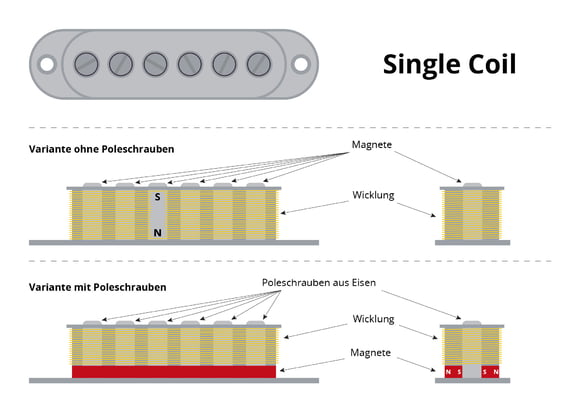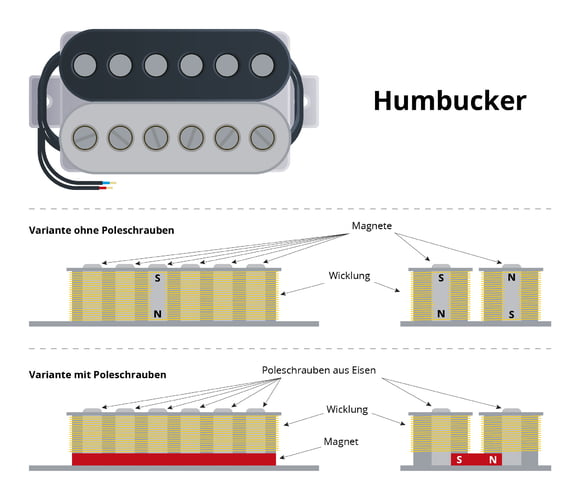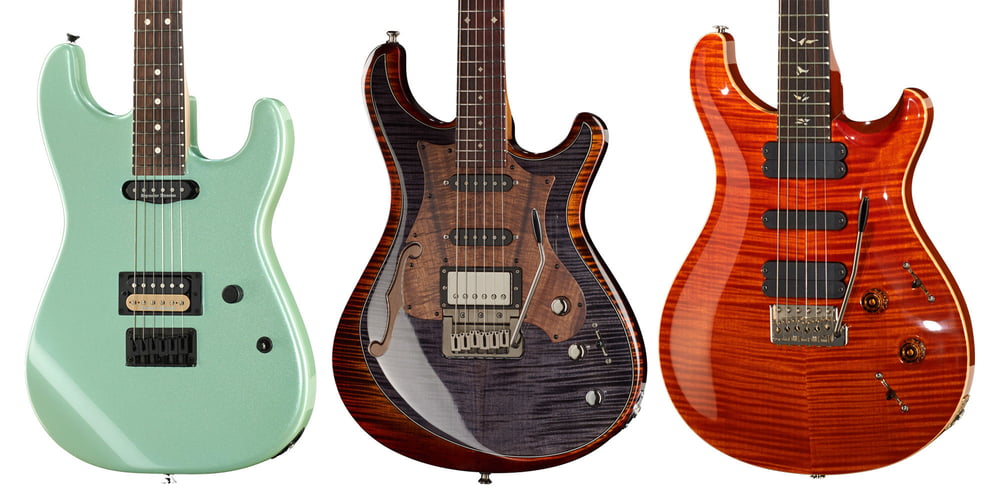3. Pickup Basics
E-guitar pickups can be divided into two major categories:
Humbuckers and Single Coils
In order to correctly describe each types we have divided our guide in two. Before we get soldering though, here are some basics that can be applied to both types:
The differences between them are primarily to do with their construction. If a single coil pickup, as the name implies, consists of a single coil, then a humbucker generally consists of two coils. These conceptual differences are directly responsible for the sound characteristics typical to each style.


A single-coil pickup is quite sensitive to external electromagnetic influences and anyone who has ever played a Strat in front of a computer monitor knows what we're talking about. Not only computers but neon lights in rehearsal rooms, or any kind of transformer, can quickly lead to a hum. Despite the increased noise level, the sound of single coils is unarguably good and any associated noise is gladly accepted as a result. An advantage of the single coil design is that they are very precise, reproducing even the smallest nuances in play, allowing for a much more dynamic sound.
Humbuckers on the other hand produce no hum and usually have a stronger/louder sound. The two coils of these pickups are combined with one other in such a way that interference is eliminated and the power of both coils is used. This leads to their stronger sound and, as a result, the ability to create incredible amp overdrive. The sound produced is also more centered and smooth than that of a single coil.
The best of both worlds - humbucker and single coil combos
For awhile there was a relatively clear separation of the two concepts and their sounds. The Les Pauls as well as their close and distant relatives were associated with fat humbucker sounds. The Strat and its single coils, on the other hand, is associated with a more open, bluesy single-coil distortion sound in addition to the typical wiry, hollow and clean sound.
As the different types offer unique advantages and because many guitarists wanted to be able to use both at the same time, there was change in the 70's. The industry took notice and soon there were guitars being offered with room for both styles in the bodies. A popular example of this are the Strats of guitar legend Eddie Van Halen in which, in addition to the standard single coil pickups, powerful humbuckers were used.
The fact that this approach is able to satisfy the sound needs of the majority of guitarists has made it a standard in todays market.
Normally, in the case of the 'hybrid guitars' just described, the pickup combination S-S-H is used, that is a single coil pickup in the neck and middle position and a humbucker in the bridge position. Many 'stratstyle' guitars are fitted with this equipment as standard and are generally sold under the name 'Rock Strat'. A second version, even more versatile in its sound spectrum, is the combination H-S-H, with a humbucker in bridge and neck position and the obligatory single coil in the middle. Allowing guitars with these combos to produce all the trendy, basic sounds present in rock, pop, jazz and blues without missing a beat.

- Some guitars are listed as having active pickups. Aren't all pickups active?
- The pickups on my vintage guitar say ''airbucker'' - is that a good thing?
- What do I need an F-spaced pickup for?
- What is special about a MIDI-pickup?
- What are RWRP pickups used for?
- I'm looking for a humbucker that has the same look as a standard single coil pickup - is that possible?
- I cannot get my tube amp to distort correctly - am I using the wrong pickups?
- How can I know for sure if the pickup is switched out of phase?
- What does out of phase mean?
No they aren't. Most of them are actually passive. With an active pickup there is a built-in preamplifier installed in the guitar that ensures noise-free operation and a low-impedance signal which won't diminish regardless of the length of the signal path / cable length.
Depends on what you want really, these will be DiMarzio pickups with a weaker magnetic field, resulting in lower output but a more sustained and dynamic sound.
F-spaced pickups were created specifically for use with guitars that have Floyd Rose tremolo systems installed. The distance between the two poles is a bit more ample and, as with standard pickups with standard systems, this guarantees the best detection of the individual strings. Depending on the manufacturer, this design is also called a trembucker.
A MIDI-pickup is needed in order to transfer analog data, such as that received from strumming a guitar, to an interface which then converts the information to MIDI data. With MIDI data a synthesizer can play any imaginable sound, this means that there is the possibility to reproduce guitar sounds on a keyboard, for example.
Reverse Wound/Reverse Polarity pickups are single coil pickups designed specifically for use in the middle position of guitars with a typical 3 single-coil set-up. The coils of RWRP pickups are, as you may imagine, wrapped in reverse and the magnet's poles are reversed in comparison to the standard pickups. This is so that they can be connected with both the bridge and neck pickups to give that typical humbucker effect.
Yes! They even have a special name, ''stacked'' pickups. With stacked humbuckers the coils are placed one over the other, rather than side by side. This way they still have the same look as a single coil pickup.
To give amps more power and produce better distortion you can install high distortion pickups which have an especially high output power, helping the amp along so to speak.
Two pickups which are in phase will sound normal - full and clean. Out of phase humbuckers sound thin and nasally. The reason for this is that all the bass and mids get swallowed up in this mode.
To explain the effect better we can use an example with speakers: when a sound is simultaneously transmitted through two loudspeakers that are working "in phase", it is bold and loud. If the speakers are out of phase the membrane of one speaker moves forward while the other moves backwards. Resulting in a thin and quiet sound.
To create the out of phase sound two connected pickups work, in simplest terms, against one another. This causes the frequencies to cancel out, giving a thin and piercing sound.






